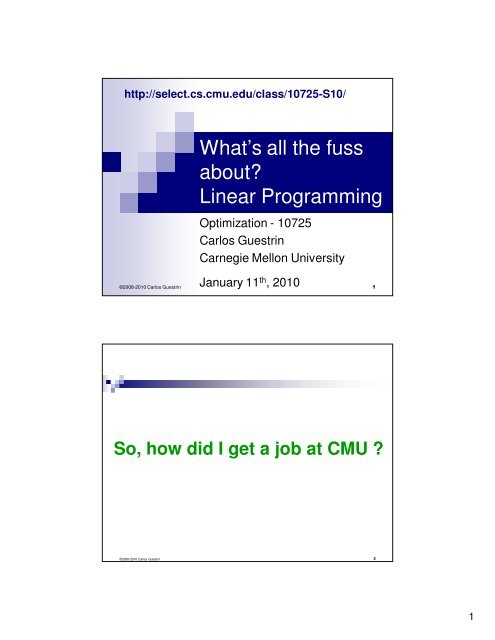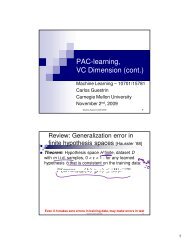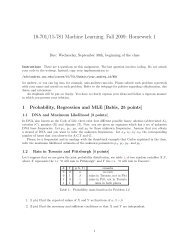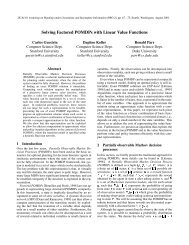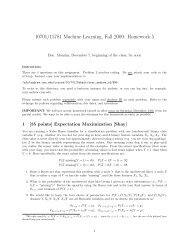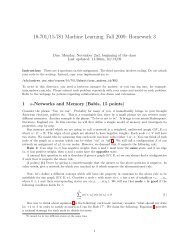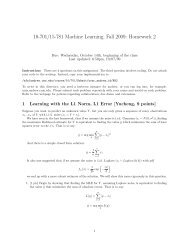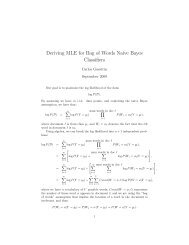Slides - Carnegie Mellon University
Slides - Carnegie Mellon University
Slides - Carnegie Mellon University
You also want an ePaper? Increase the reach of your titles
YUMPU automatically turns print PDFs into web optimized ePapers that Google loves.
http://select.cs.cmu.edu/class/10725-S10/What’s all the fussabout?Linear ProgrammingOptimization - 10725Carlos Guestrin<strong>Carnegie</strong> <strong>Mellon</strong> <strong>University</strong>January 11 th , 2010©2008-2010 Carlos Guestrin 1So, how did I get a job at CMU ?©2008-2010 Carlos Guestrin21
How? How? How? Hoooooow? OK, we all know it was a mistake, but how? Multiagent coordination… There were many heuristics out there “first you do this, than you do that, then you pray…” Formulated an optimization problem linear program Unique optimum, no local minima, find it in polytime on thenumber of variables and constraints Polynomial number of variables One constraint for each state and action©2008-2010 Carlos Guestrin3LP decomposition technique Need to solve multiagent problems with linearprogram with exponentially-many constraints Problem has structure (similar to graphical models)©2008-2010 Carlos Guestrin42
Power Grid Problem1009080706050403020100DR [Schneider+al '99]DVF [Schneider+al '99]Factored Multiagent no comm.Factored Multiagent pairwise comm.A B C DGridLower is better!©2008-2010 Carlos Guestrin5Linear classifiers – Which line is better?Data:Example i:w.x = ∑ j w (j) x (j)©2008-2010 Carlos Guestrin63
Support vector machines (SVMs)“Machine Learning discovers convexoptimization” - Tom DietterichSolve efficiently by quadraticprogramming (QP) Well-studied solution algorithmsHyperplane defined by supportvectors©2008-2010 Carlos Guestrin7Dual SVM: the “kernel trick”!Never represent features explicitly Compute dot products in closed formConstant-time high-dimensional dotproductsfor many classes of features©2008-2010 Carlos Guestrin84
Inference in graphical modelsWant to compute posterior distributionCoherenceVery hard problem…DifficultyIntelligenceThere were many heuristics… Unstable, local optima, no guarantees… But can we find “best approximation”?E.g., lowest KL divergence?HappyGradeLetterJobSATNo, but… Can formulate convex approximationVariational methods Stable, no local optima, often very effective“Graphical models discover convexity”©2008-2010 Carlos Guestrin9The regression problem Instances: Learn: Mapping from x to t(x) Hypothesis space: Given, basis functions Find coeffs w={w 1 ,…,w k } Why is this called linear regression??? model is linear in the parameters Precisely, minimize the residual squared error:©2008-2010 Carlos Guestrin105
Overfitting and RegulatizationX^0 * 0.5978945307598738X^1 * 2.340201179939286X^2 * -0.2518661564155983X^0 * 2186.1840042933895X^1 * -16469.863162589896X^2 * 52512.21531414815X^3 * -95140.78449247137X^4 * 110662.42418814528X^5 * -88277.46566570339X^6 * 50266.25653442256X^7 * -20945.151255487497X^8 * 6480.3454987076375X^9 * -1498.2612106472752X^10 * 258.5241805962563X^11 * -32.9723896102697X^12 * 3.0455789461745604X^13 * -0.196424297260513X^14 * 0.00829064821420466X^15 * -2.0200453027411646E-4X^16 * 2.082281731309957E-6©2008-2010 Carlos Guestrin11Penalize large weights(Regularization)L 2 L 1©2008-2010 Carlos Guestrin126
Maximum Entropy PrincipleSuppose you know: “On average 1/4 of the people smoke and have cancer”Expected value of a feature: More generally, given a set of features f 1 ,…,f n , you know:What’s a good representation for the distribution? If you have commitment problems, maximum entropy!Solve optimization problem:Seems hard, but…©2008-2010 Carlos Guestrin13I only know maximum likelihoodestimation Maximum entropy problem: Here is a completely different problem: Maximize data likelihood for a log-linear model©2008-2010 Carlos Guestrin147
Image Segmentation Problem Many heuristics… “Do this, do that, hope for the best…”Unstable, local optima,… “Computer vision communitydiscovers approximationalgorithms for combinatorialoptimization” E.g., normalized cuts [Shi] Stable approximation, converges tosingle optimum Huge impact on vision community[Jianbo Shi]©2008-2010 Carlos Guestrin15Robust experimental designpH value3210-1Confidencebands3210-1-2-3Horizontal positions VTypical objective:Minimize average variance (MSE)-2-3Low average variance (MSE)but high maximum(in most interesting part!)Want to select measurement locations to minimize variance at worst caselocation©2008-2010 Carlos Guestrin168
Is it possible to find near optimalsolution to minimax Kriging? Unless P=NP, there is no approximation algorithm State of the art: Simulated annealing with 7 hand-tuned parameters©2008-2010 Carlos Guestrin17Key property: diminishing returnsplacement A = {S 1 , S 2 } placement B = {S 1 , S 2 , S 3 , S 4 }S2S3S2S’S1S1S4Adding S’will help a lot!S’Newsensor S’Adding S’doesn’t help much©2008-2010 CarlosGuestrin 189
Submodular FunctionsBA+XMore reward+XLess reward©2008-2010 Carlos Guestrin19Exploiting submodularity [Krause et al. ‘07] Unless P=NP, there is no polytime approximation algorithm for: max A min i F i (A) for |A|=k SATURATE achieves optimal value with only slightly more than k sensors min i F i (A S ) ≥ min i F i (A OPT ) for |A S | ≥ αk α = 1 + log(max s∈V ∑ i F i (s)) Unless NP ⊂ Dtime(n log log n ), no polytime algorithm achieves min i F i (A S ) ≥ min i F i (A OPT ) for |A S | ≥ βk β < 1 + log(max s∈V ∑ i F i (s))©2008-2010 Carlos Guestrin2010
Comparison with state of the art:Minimax Krigingalgorithm used in geostatistics: simulated annealing[Sacks & Schiller ’88, van Groeningen & Stein ’98, Wiens ’05,…]better7 parameters that need to be fine-tunedMaximum marginal variance0.250.20.150.10.05but these instances were easygreedy did OK…SimulatedAnnealingGreedySaturate00 20 40 60Number of sensorsEnvironmental monitoringmaximum marginal variance2.521.51greedySimulatedAnnealingSaturate0.50 20 40 60 80 100number of sensorsPrecipitation dataSaturate is competitive & 10x faster©2008-2010 CarlosGuestrin 21No parameters to tune!Results on water networkslower is bettermaximum detection time (minutes)30002500200015001000500SaturategreedysimulatedAnnealing00 10 20number of sensorsno decreaseuntil allcontaminationsdetected!water networks60% lower worst-case detection time!©2008-2010 CarlosGuestrin 2211
Where we are going…Have a complex problemNot too long ago: Design “algorithm”Not even know what is being optimizedHope for the bestNow: Formulate optimization problem and find efficient solution, exploitingstructure Convexity, locality, decomposition, submodularity,…But be careful, you still need to understand what you are doing…©2008-2010 Carlos Guestrin23Optimization has (finally)become fundamental Just talked about lots of applications, but this class: Understand classes of optimization problems What is the “right” optimization class for the task What are good solution methods How to exploit the right structure Focus on formulation and efficient solutions, rather than“proving optimization theory results” Sample applications (mostly) in machine learning, butclass not about machine learning©2008-2010 Carlos Guestrin2412
Syllabus Covers a wide range of topics – from basic tostate-of-the-art You will learn about the methods you heard about:Linear programming, quadratic programming, duality, Lagrange multipliers, largescalesolutions, separation oracles, Dantzig-Wolfe & Benders decompositions,constraint generation, ellipsoid method, subgradient, dynamic programming, convexsets, functions and programs, duality of functions and sets, SDPs, geometricprograms, SOCPs, interior point methods, online algorithms, mixed integerprograms, LP relaxations, cutting planes, search, submodularity, kitchen sink,… It’s going to be fun and hard work ☺©2008-2010 Carlos Guestrin25PrerequisitesAlgorithms Dynamic programming, basic data structures, complexity…Programming Mostly your choice of languageLinear Algebra Matrix operations, linear subspaces, projections,…Machine learning? Sample applications mostly in ML. Background in ML (e.g., 10701/15781)helpful, but not required.We provide some background, but the class will be fast pacedAbility to deal with “abstract mathematical concepts”©2008-2010 Carlos Guestrin2613
Recitations Very useful! Review material Present background Answer questions Probably Thursdays, 4:30 or 5:00, will announcesoon. There will be a review of linear algebra©2008-2010 Carlos Guestrin27Staff Two Instructors Geoff Gordon Carlos Guestrin Two Great TAs: Great resource for learning, interact withthem! Sivaraman Balakrishnan Yi Zhang Administrative Assistant Michelle Martin©2008-2010 Carlos Guestrin2814
First Point of Contact for HWs To facilitate interaction, a TA will be assigned to eachhomework question – This will be your “first point ofcontact” for this question But, you can always ask any of us Discussion group: We have a discussion group where you can post questions, discussissues, and interact with fellow students. Please join the group andcheck in often: We will do all announcements on this list!!! http://groups.google.com/group/10725-s10 For e-mailing instructors, always use: 10725-instructors@cs.cmu.edu Just in case, for announcements, subscribe to: 10725-announce@cs https://mailman.srv.cs.cmu.edu/mailman/listinfo/10725-announce©2008-2010 Carlos Guestrin29Text Books Textbook: Convex Optimization, Boyd and Vandenberghe, which isavailable online for free. Optional textbooks: Combinatorial Optimization: Algorithms and Complexity, ChristosPapadimitriou and Kenneth Steiglitz. Combinatorial Optimization, Alexander Schrijver. Nonlinear Programming, Dimitri Bertsekas. Approximation Algorithms, Vijay Vazirani©2008-2010 Carlos Guestrin3015
Grading 5 homeworks (50%) First one goes out in a week Start early, Start early, Start early, Start early, Start early,Start early, Start early, Start early, Start early, Start early Final project (30%) Your chance to do something cool with optimization Projects done individually, or groups of two students Final (20%) Take home Out: Wed, April 28 Due: Mon, May 3 (noon, no late days)©2008-2010 Carlos Guestrin31Homeworks Homeworks are hard, start early ☺ Due in the beginning of class 3 late days for the semester After late days are used up, points will be deducted as outline All homeworks must be handed in, even for zero credit Late homeworks handed in to Michelle Martin in GHC 8001Collaboration You may discuss the questions Each student writes their own answers Write on your homework anyone with whom you collaborate Each student must write their own code for the programming part Please don’t search for answers on the web, Google, other classes’homeworks, etc.please ask us if you are not sure if you can use a particular reference©2008-2010 Carlos Guestrin3216
Sitting in & Auditing the ClassNot sure we have room for auditors/sit inDue to new departmental rules, every student who wants to sit in theclass (not take it for credit), must register officially for auditingTo satisfy the auditing requirement, you must either: Do *two* homeworks, and get at least 75% of the points in each; or Take the final, and get at least 50% of the points; or Do a class project and do *one* homework, and get at least 75% of thepoints in the homework;Only need to submit project proposal and present poster, and get at least80% points in the poster.Please, send us an email saying that you will be auditing the classand what you plan to do.If you are not a student and want to sit in the class, please getauthorization from the instructor©2008-2010 Carlos Guestrin33Enjoy! Optimization is ubiquitous in science,engineering and beyond This class should give you the basic foundationand expose you to state of the art methods andapplications The fun begins…©2008-2010 Carlos Guestrin3417
Maximizing revenuen products, how much do we produce of each? Amounts: Profit for each product:m resources, quantities:Each product uses a certain amount of each resource:What’s the optimal amount of each product?©2008-2010 Carlos Guestrin35Maximum flow, directed graph Given a set of one-way streets directed graph Edges (i,j) ∈ E Each edge has a capacity How much traffic can flow from source to destination?©2008-2010 Carlos Guestrin3618
L 1 RegressionLeast-squares regression:L 1 regression:Absolute values, not linear… how can this be solved???©2008-2010 Carlos Guestrin37General Form of Linear Program©2008-2010 Carlos Guestrin3819
LPs are cool Fourier talked about LPs Dantzig discovered the Simplex algorithm in 1947 Exponential time Versions of simplex are still among fastest LP solvers Many thought LPs were NP-hard… First polytime algorithm: Khachiyan1979, first practical Karmarkar 1984 Considered “hardest” polytime problem Many, many, many, many, many important practical apps Can approximate convex problems Basis for many, many, many, many approximation algorithms©2008-2010 Carlos Guestrin3920



